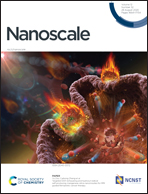Boosting the energy storage performance of V2O5 nanosheets by intercalating conductive graphene quantum dots†
Abstract
2-Dimensional (2D) transition metal oxides are an emerging class of energy materials that offer a wide spectrum of potential applications in electrochemical energy storage. In this study, V2O5 nanosheets have been nano-engineered with 0D graphene quantum dots (GQDs) via a solvothermal treatment process, and they serve as an anode material to boost electrochemical energy storage properties. The interlayer embedded GQD endows V2O5 (VNS-GQD) with structural and compositional advantages for high-performance energy storage, including expanded interlayer distances between layers, fast electrochemical kinetics, and additional stability to buffer the volume variation. Moreover, the strong coupling effect between GQDs and VNS, an ultra-large interfacial area and enhanced electrical conductivity promote the intercalation pseudocapacitance. VNS-GQD exhibits the specific capacitance of 572 F g−1 at a current density of 1 A g−1 and retains 92% of the initial capacitance after 10 000 charge–discharge cycles. The asymmetric supercapacitor exhibits superior electrochemical performance at a voltage window of 1.5 V. The energy density is 31.25 W h kg−1 at the power density of 2.25 kW kg−1, and maintains a superior energy density of 20.62 W h kg−1 at the high power density of 14.86 kW kg−1. The results of this study can provide an avenue for fabricating nano-sandwiched composites by embedding GQDs into interlayers of 2D transition metal oxide for ultra-high performance applications of energy storage devices.



 Please wait while we load your content...
Please wait while we load your content...